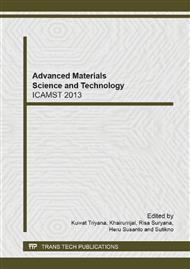[1]
G. Steieglitz, Parallels between aviation and automotive safety research, in: Passenger car design and highway safety, Association for the Aid of Crippled Children and Consumer Union of U.S. Inc, New York, 1962, p.194.
Google Scholar
[2]
S. Newstead, L. Watson, M. Cameron, Vehicle safety ratings estimated from police reported crash data: 2008 update. Australian and New Zealand crashes during 1987-2006, Monash University Accident Research Center Report, Report No. 280, (2008).
Google Scholar
[3]
V. P. McConnell, Automotive composite: A design and manufacturing guide, Ray Publishing, Wheat Ridge, 1997, pp.6-7.
Google Scholar
[4]
R. Piellisch, Beyond gasoline: Autos remains elusive for carbon composite structures, but alternative cars still hold a great market potential, Soc. for the Advancement of Material and Process Engineering. Journal 32 (1997) 1165-1186.
Google Scholar
[5]
G. Belingardi, M. P. Cavatora, D. S. Paolino, Repeated impact response of hand lay-up and vacuum infusion thick glass reinforced laminates, Int. J. Impact Eng. 35 (2008) 609-619.
DOI: 10.1016/j.ijimpeng.2007.02.005
Google Scholar
[6]
H. Wallentowitz, I. Leyer, and T. Pharr, Material for future automotive body structure, Business Briefing: Global Automotive & Manufacturing, Reference Section, 2003, pp.1-4.
Google Scholar
[7]
G. Lu, T. X. Yu, Energy Absorption of structure and material, Woodhead Publishing, Cambridge, 2003, p.317.
Google Scholar
[8]
J. L. James, Carbon Fibers, in: Chemical Insight & Forecasting: IHS Chemical, Process Economics Program Report, Report No. 165, (1983).
Google Scholar
[9]
J. L. James, Carbon Fibers, in: Process Economics Program Report, Chemical Insight & Forecasting: IHS Chemical, Report No. 165A, (1992).
Google Scholar
[10]
A. K. Kaw, Mechanics of Composite Materials, second ed., CRC Press, Taylor & Francis Group, Tampa, (2005).
Google Scholar
[11]
ASTM Standard D638-02, Standard Test Method for Tensile Properties of Plastics, Annual Book of Standards, ASTM International, West Conshohocken, PA, 2003, pp.46-58.
Google Scholar
[12]
ASTM Standard D 790-02, Standard Test Method for Flexural Properties of Unreinforced and Reinforced Plastics and Electrical insulating materials, Annual Book of Standards, ASTM International, West Conshohocken, PA, 2002, pp.146-154.
Google Scholar
[13]
S. Y. Fa, X. Hu, C. Y. Yue, Effect of fiber length and orientation distributions on the mechanical properties of short-fiber-reinforced-polymers: A Review, Mater. Sci. Res. Int. 5 (1999) 74-83.
Google Scholar
[14]
K. S. Bernstein, R. Kujala, V. Fogt, P. Romine, Structural design requirements and factors of safety for spaceflight hardware: For human spaceflight, JSC 65828 Rev. A, NASA JSC, Houston, TX, (2011).
Google Scholar


